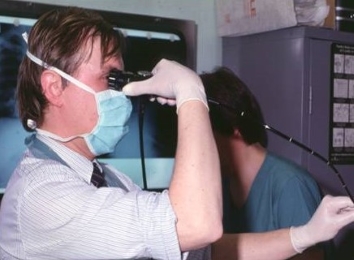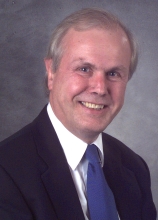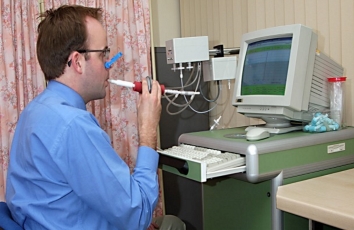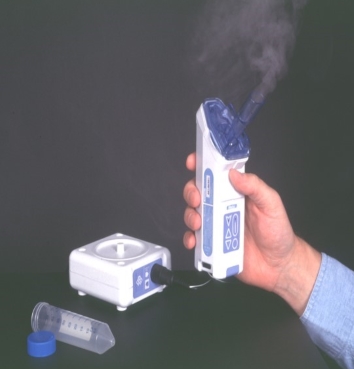Respiratory Medicine
Development within the NHS and the University of Glasgow
Tuberculosis in the West of Scotland
In the 1950’s, respiratory tuberculosis (TB) was a major health problem in the West of Scotland, particularly in Glasgow, with approximately 200 new cases per 100,000 of the population. The NHS tackled tuberculosis by developing specialist hospitals in the Western Regional Hospital Board area, including Ruchill Hospital, Robroyston Hospital and Mearnskirk Hospital in Glasgow and by recruiting specialist medical and nursing staff.
A miniature mass radiography service was established in 1957 with the aim of finding all undetected cases of tuberculosis in the community. The TB service remained outwith the general hospital service until the late 1960’s. Over the subsequent decades, the number of new cases of tuberculosis has gradually reduced, allowing the Mass Radiography Centre to close in 1988 (Director, Dr Kantilal R Patel). Pulmonary tuberculosis has not disappeared, with new cases still being reported, particularly in high risk groups, such as recent immigrants, individuals with a history of drug or alcohol abuse, and people who have HIV.
A new specialty evolves
In the early 1970’s, as the number of cases of TB declined, the new specialty of respiratory medicine evolved and the management of respiratory TB cases was included in general hospital services. Respiratory diseases such as asthma, chronic obstructive pulmonary disease (COPD) and lung cancer became a major focus of the new clinical service and of research. Specialist respiratory departments were established in the main teaching hospitals.
Dr James W Kerr established a department in the Western Infirmary, Glasgow, linked with respiratory services at Knightswood Hospital. Dr Kerr developed the intensive care unit at the Western Infirmary, and had major clinical interests in asthma and allergic disorders. Dr Frank Moran established a specialist respiratory unit in Glasgow Royal Infirmary, linked with respiratory services at Belvidere Hospital (Dr Sinclair Kennedy).
From the 1970s through to the late 1990s, there was increasing subspecialisation of NHS clinical services for respiratory diseases, which resulted in the development of:
- the West of Scotland Adult Cystic Fibrosis Unit in 1992 (First Director, Dr Bryan H R Stack)
- sleep and ventilatory services (Dr Stephen Banham and Dr Kantilal R Patel)
- severe asthma clinics (Professor Neil C Thomson and Dr Christine Bucknall)
- the Scottish National Pulmonary Vascular Unit, for management of pulmonary hypertension, in 1998 (First Director, Professor Andrew J Peacock)
- supported discharge services for chronic obstructive pulmonary disease (COPD) (Professor Robin D Stevenson)
- specialist paediatric respiratory services (Dr James Paton)
- lung cancer services

In the 1970s, new diagnostic techniques became available for the investigation of lung diseases, which resulted in the creation of specialist lung function laboratories at Glasgow Royal Infirmary (Dr Frank Moran and Dr Reg Mills) and the Western Infirmary (Dr Kantilal R Patel), and the development of diagnostic fibreoptic bronchoscopy services. Therapeutic bronchoscopic procedures were introduced including the use of endobronchial laser therapy as a palliative treatment for inoperable cancers of the main bronchi.
More recently, new respiratory outpatient facilities have been opened at Stobhill Hospital, the Victoria Infirmary and the Queen Elizabeth University Hospital, in addition to those established at Gartnavel General Hospital and Glasgow Royal Infirmary.

In 1996, the University of Glasgow awarded Neil Thomson an honorary professorship, and in 2001, he transferred from an NHS consultant post to become Professor of Respiratory Medicine. A major focus of his research was corticosteroid resistance in asthma, biomarkers in asthma and COPD, and novel treatments for severe asthma including bronchial thermoplasty. The academic positions of Senior Lecturer in paediatric respiratory disease (1989) and Reader (2003) have been held by Dr James Paton, based in the School of Medicine, Dentistry & Nursing, Child Health and The Royal Hospital for Sick Children, Glasgow. Dr Malcolm Shepherd was appointed a clinical senior lecturer in translational medicine (2008) and in 2010, he took up a full-time clinical NHS consultant post that includes directorship of the West of Scotland Anaphylaxis Service.
Dr Shepherd is currently Deputy Head of the Undergraduate School (Clinical) and Director of MBChB 4 (2018). Honorary professorships were awarded to Andrew Peacock in 2001, and to Robin Stevenson in 2007. NHS consultants in respiratory medicine in the West of Scotland hold honorary clinical associate professorships or senior lectureships. Professor Thomson retired in 2011.
Research focus
Research in respiratory medicine in the West of Scotland has been predominately clinical and translational and has focused on specific respiratory diseases:
Asthma

Neil Thomson had a major interest in the adverse influence of cigarette smoking on clinical and inflammatory outcomes in asthma. He discovered that corticosteroid insensitivity is an important cause of poor asthma control in smokers with asthma. Neil Thomson, James Kerr and Kantilal Patel investigated the role of parasympathetic and adrenergic nerve system in the control of airway calibre.
Neil Thomson and Kantilal Patel undertook clinical trials of novel interventions and new pharmacological therapies for the treatment of asthma. James Paton has a major interest in health service research in paediatric asthma care, and highlighted the importance of non-adherence with anti-asthma therapies in the management of childhood asthma. In the 2000’s, basic science studies were undertaken by Professor Foo (Eddy) Y Liew (Immunology) into inflammatory mechanisms in experimental models of asthma.
Pulmonary vascular disease
Andrew Peacock undertook a programme of research into understanding the cellular and molecular mechanisms of chronic hypoxic pulmonary hypertension, and in the assessment and development of novel pharmacological treatments for pulmonary hypertension.

COPD
Robin Stevenson and Christine Bucknall pioneered the use of Hospital at Home for patients admitted to hospital with exacerbations of COPD.
Extrinsic allergic alveolitis (pigeon fanciers' disease)
Gavin Boyd, Charles McSharry and Stephen Banham undertook a series of clinical and community studies into the clinical features and inflammatory mechanisms of Pigeon Fanciers’ Disease.
Lung Cancer
Bryan Stack was the first chair of the West of Scotland Lung Cancer Group. This Group had an important role overseeing therapeutic studies in lung cancer, including the early use of intensive chemotherapy for small cell carcinoma (Stephen Banham, Stan Kaye, Oncology, and Alan Burnett, Haematology), investigations into clinical and palliative care aspects of lung cancer (Robert Milroy) and in pioneering the development of multi-disciplinary teams to discuss the management of lung cancer cases, including links with cardiothoracic surgery (Ken Davidson, Royal Infirmary and Murdo Turner, Western Infirmary). In 2002, the West of Scotland Managed Clinical Network for Lung Cancer was formed (see Thoracic Surgery).
Professor Neil Thomson
*Mass X - Ray image courtesy of NHS Greater Glasgow and Clyde Archives
Other images provided by Professor Thomson


